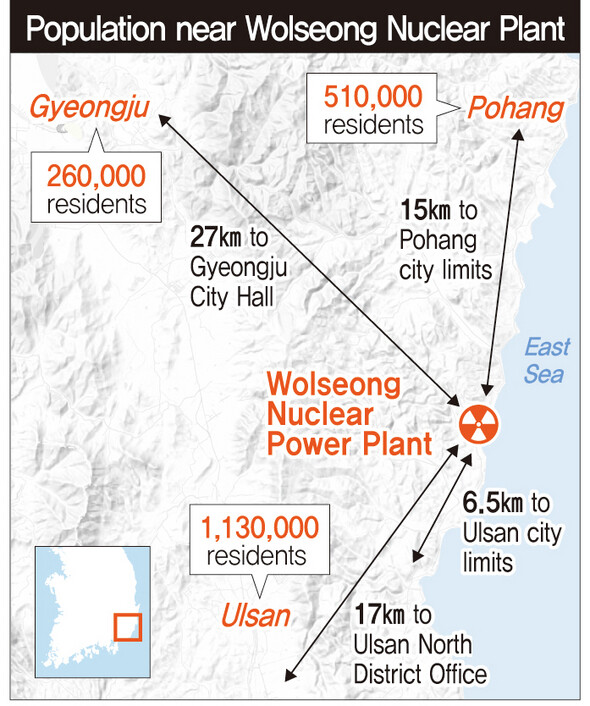hankyoreh
Links to other country sites 다른 나라 사이트 링크
Residents seek input on nuclear plant extension

By Lee Keun-young, senior staff writer
The Wolseong No. 1 Nuclear Power Plant in Gyeongju, North Gyeongsang province, will complete its design life of thirty years on Nov. 20 of this year.
In Dec. 2009, the Korea Hydro & Nuclear Power Company (KHNP) submitted a request to the Ministry of Education, Science and Technology to extend its lifespan. That request is now under review. If the No. 1 reactor has its operation period extended, it will be second nuclear power plant in South Korea living on borrowed time. The Gori No. 1 plant in Busan‘s Gijang County was extended in 2008.
In addition to those two, there are a total of eight plants in South Korea that will finish their design lives by 2030. Decisions will need to be made on whether to extend their operations.
A nuclear power plant’s design life is the minimum period in which it is possible to operate a plant while meeting the safety and performance standards at the time of its design. Plant operators hope to prolong their use to avoid the cost of constructing new plants. South Korea’s Atomic Energy Act permits continued operation for plants that pass a safety assessment.
That act stipulates that extension applications are to be reviewed after the submission of reports from regular safety assessments, radioactivity impact assessments, along with major equipment safety assessments to the Nuclear Safety & Security Commission.
Nuclear power plants operating after the extension of their design lives pose higher safety risks than newly constructed plants. The lack of efforts to consider the opinions of residents within the plants’ vicinities and establish a national census is now becoming a source of controversy. Observers said the Fukushima No. 1 Power Plant in Japan, which was the site of a major disaster in March 2011, caused greater damage because its design life was extended a month before the accident.
The Atomic Energy Act states that those seeking permission to build and operate radioactive waste disposal and spent fuel rod storage facilities must show a draft radioactivity impact assessment form. They must also disclose all relevant information and hold meetings to hear resident opinions. The Electric Source Development Promotion Act applies in cases of power plant construction and includes a passage stating that the opinions of residents and other involved parties must be heard.
The government is pushing to make the handling of spent fuel rods a matter of public discussion in order to establish a consensus among citizens. But there is nothing about gathering resident opinions anywhere in the Atomic Energy Act’s provisions on design life extension. The application process to extend the Wolseong No. 1 reactor’s design life included no resident hearings at all.
Lee Sang-hong, secretary-general of the Gyeongju chapter of the Korea Federation for Environmental Movements, noted that the government recently pushed for amendment of the law to include more provisions on consultation with local residents when building new power plants, noting that setbacks were occurring in the electricity supply plans in cases where new plants could not be built because of resident objections.
“The agreement of local citizens should be a prerequisite for the extension of reactors’ life spans,” Lee said.
During the nuclear crises in Chernobyl and Fukushima, restricted areas of 30km around the plants were put in place. In the event of an accident at the Wolseong plants, an area of this size would encompass the homes of 1.9 million residents of Gyeongju, Ulsan and Pohang municipalities. Civic groups are contending that residents of should be asked their opinions before the Wolseong No. 1 plant is put into extended operation.
Please direct questions or comments to [english@hani.co.kr]
Editorial・opinion
![[Column] Park Geun-hye déjà vu in Yoon Suk-yeol [Column] Park Geun-hye déjà vu in Yoon Suk-yeol](https://flexible.img.hani.co.kr/flexible/normal/500/300/imgdb/original/2024/0424/651713945113788.jpg) [Column] Park Geun-hye déjà vu in Yoon Suk-yeol
[Column] Park Geun-hye déjà vu in Yoon Suk-yeol![[Editorial] New weight of N. Korea’s nuclear threats makes dialogue all the more urgent [Editorial] New weight of N. Korea’s nuclear threats makes dialogue all the more urgent](https://flexible.img.hani.co.kr/flexible/normal/500/300/imgdb/original/2024/0424/7317139454662664.jpg) [Editorial] New weight of N. Korea’s nuclear threats makes dialogue all the more urgent
[Editorial] New weight of N. Korea’s nuclear threats makes dialogue all the more urgent- [Guest essay] The real reason Korea’s new right wants to dub Rhee a founding father
- [Column] ‘Choson’: Is it time we start referring to N. Korea in its own terms?
- [Editorial] Japan’s rewriting of history with Korea has gone too far
- [Column] The president’s questionable capacity for dialogue
- [Column] Are chaebol firms just pizza pies for families to divvy up as they please?
- [Column] Has Korea, too, crossed the Rubicon on China?
- [Correspondent’s column] In Japan’s alliance with US, echoes of its past alliances with UK
- [Editorial] Does Yoon think the Korean public is wrong?
Most viewed articles
- 1‘We must say no’: Seoul defense chief on Korean, USFK involvement in hypothetical Taiwan crisis
- 2‘Weddingflation’ breaks the bank for Korean couples-to-be
- 3[Reportage] On US campuses, student risk arrest as they call for divestment from Israel
- 4[Column] Park Geun-hye déjà vu in Yoon Suk-yeol
- 5Amnesty notes ‘erosion’ of freedom of expression in Korea in annual human rights report
- 6Korea sees more deaths than births for 52nd consecutive month in February
- 7N. Korean delegation’s trip to Iran shows how Pyongyang is leveraging ties with Moscow
- 8Will NewJeans end up collateral damage in internal feud at K-pop juggernaut Hybe?
- 9[Guest essay] The real reason Korea’s new right wants to dub Rhee a founding father
- 10N. Korean hackers breached 10 defense contractors in South for months, police say